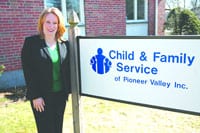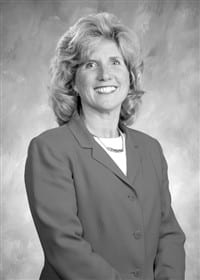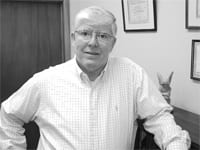To Protect and Serve Valley’s Oldest Human Services Agency Reorganizes for a Changing World
That’s a fact that most people don’t realize – in 1877, a band of civic-minded volunteers, according to Child and Family Service’s history, created the Union Relief Assoc., to serve as ‘friendly visitors’ to people who were ill, out of work, or single parents.
A lot has changed since the 1870s, but the goal to serve as advocates for neighbors is one aspect of the organization’s mission that has persisted, according to Cynthia Sommer, director of development for Child and Family Service.
“We’ve transformed many, many times,” she said, referring to a number of name changes as well as additions and modifications to services. “Of course, deinstitutionalization happened in the 1960s, and that’s when many agencies such as ours first appeared. But we can track our evolution all the way back to the 1920s, when the professionalization of social work first occurred, and still further back to the industrial revolution. And in many ways, that idea of ‘friendly visits’ is similar to what we do today.”
Granted, the service model has become more complicated throughout the years. Referring frequently to a written summary of the agency’s long history, Sommer said the Union Relief Assoc. formed the Children’s Aid Committee in 1879, to assist in the placement of orphans with families. The organization’s name soon changed to the Family Welfare Assoc. and then to Family Service Assoc.
In 1950, the agency merged with the Hampden County Children’s Aid Assoc. to form Child and Family Service of Springfield.
“The next merger was in 1961 when Travelers Aid Society became a part of Child and Family Service of Springfield,” she continued. “And in April 1988 we merged with the West Springfield Counseling Center, when the goal was to broaden client services and diversify funding.”
And in 1990, Child and Family Service of Springfield changed its name once again, to Child and Family Service of Pioneer Valley. Over that decade it merged two more times – with Cerebral Palsy and Developmental Services of Western Mass., and with a local mental health clinic providing in-home mental health services in Hampden County with offices in Greenfield and Worcester.
Michelle Theroux, Child and Family Service’s newly-appointed executive director, said that despite several permutations that span two centuries, the mission of Child and Family Service has remained constant: “to strengthen and promote the quality of life for children, adults, and families through education, counseling, and support.”
A Building Year
Theroux should know a lot about major changes to the agency – she’s one of them.
She comes to her new post after serving as director of Family Networks for 6 years with the Key Program in Springfield, an early childhood services program. Theroux, who took the helm on March 6, sat with The Healthcare News to discuss some her own goals for Child and Family Service, as well as some of the challenges the agency will meet in the coming year.
“Creating a cohesive continuum of care is my goal,” she said. “Providing greater access to different programs for the people in the community, and the further development of a team with the internal ability to effectively share communication, to best serve that community.”
That’s no easy feat within an agency that has become as expansive as Child and Family Service. Home visits are still a large piece of the agency’s repertoire, however today they’re just one part of a wide gamut of services. Those include:
• Counseling and mental health services, including a licensed mental health and substance abuse clinic;
• The Family Preservation Program, which provides parent education, family mentors, school-based prevention and parent-involvement programs, and divorce education;
• The Valley Infant Development Service (VIDS), which serves as the oldest early intervention program in Springfield for infants and toddlers at risk for developmental delays;
• A disability resource program, designed to empower people with physical disabilities through participation in adaptive sports, social activities, community resources, referrals, and education, and
• A refugee and immigrant program, which assists newcomers in adjusting to life in the U.S. through education, counseling, and support.
Even the agency’s name is misleading; it serves not only the Pioneer Valley, but Western Mass. as a whole and parts of Central Mass., with offices in Springfield, West Springfield, Greenfield, Easthampton, Athol, and Worcester. Meanwhile, clinician outreach extends not only to homes, but to schools, workplaces, and community organizations.
Theroux explained that the field of human services in general lends itself to communication among diverse entities. In fact, unlike other industries where competitive edge is key, cooperation is more prevalent and more effective among community-based non-profits, advocacy and support groups, and health care organizations that work with diverse populations. Child and Family Service fits all three of those descriptions, as do many other groups in Western Mass.
“We’re trying to do even more to collaborate with other agencies and groups,” Theroux said. “The climate of human services is one that promotes collaboration – we all build on a strength-based perspective, and therefore we need to talk to each other.”
That ‘strength-based’ model is also one that filters into the actual work clinicians and volunteers do with clients on a daily basis, she said.
Developing Networks
“We help to develop networks of support,” she explained. “We work with people day to day, but in the end, we’re paid professionals, and eventually, we won’t be there. It’s key that the children and adults we work with are given the tools they need to build strength for the tough times.”
To address that need, Theroux went on to note that another goal of the agency for the coming year will be to continue to pioneer new ways to effectively bring services to the community, and to tailor those services to diverse groups in order to remain effective.
“We’re constantly looking for opportunities to target issues in new, innovative ways,” she said. “Families today have multiple stressors coming at them, and we’re trying to shore up the resources.”
Theroux added that a number of contracts and grant proposals for new programs are pending – she hopes to receive positive word on all or most of them by June. Child and Family Service is funded primarily through state grants and third-party reimbursements, although agency-wide fundraising efforts are ongoing year-round as well.
Theroux said the agency tries to tailor fundraising events to reflect the clientele of each office – a motorcycle rally is a big hit in North Quabbin, for instance, and an annual charity golf tournament is scheduled for August 2 in Agawam.
“A lot of our fundraising efforts are small and local, because we are comprised of small, local offices,” she said. “We have a lot of different pockets of families to serve, and it’s one part of trying to reflect those families.”
Different areas, she explained, even respond as a whole differently to various types of treatment and service, she said. And with Child and Family Service’s clientele mirroring the diverse populations of Western and Central Mass., reflecting those communities is as important as responding to them.
“North Quabbin, for instance, is very rural,” Theroux said, “while Springfield is very urban. There are pros and cons to both – access to services is easier in the urban areas because it’s more central, and transportation is less of an issue. But in terms of substance abuse, often the drugs being abused will differ from area to area. “
Cultural and language differences also come into play on a daily basis. With a variety of ethnic groups, including Latinos, Russians, and Vietnamese well represented in the area, it becomes imperative that information regarding one’s health and wellbeing are not lost in translation.
“Human service agencies have to be mavericks,” said Theroux. “It often becomes a matter of being really creative in the ways you service and support your community, while at the same time protecting sensitive information. It is definitely a struggle to find and retain employees that can reflect the community.”
Intriguing Proposals
That’s just one of several issues that Theroux hopes to address through a number of proposals recently sent to the Department of Social Services (DSS), a major referral network for Child and Family Service. They were submitted in response to a request for proposals for new programming that would assist in a major reorganization at DSS.
The reorganization, Theroux explained, was initiated to redesign the state’s model for purchase of services, as well as to take into greater account creativity and flexibility among service providers such as Child and Family Service. Initiatives include a greater emphasis on cultural diversity, focus on the changing needs of children, and strength-based programs for families.
It’s a massive undertaking by DSS, said Theroux, but one she is hopeful will have dramatic, and positive, impact on the field of human services in general.
“Under a lead model, this reoganization aims to create a network of providers like us that are meeting varied yet specific needs of families,” she said, noting that Child and Family Service submitted four proposals to be implemented under its Family Preservation program that would create a greater collaboration with the agency’s mental health arm.
“The best case scenario is that all four proposals will be accepted and fully funded,“ she said, “and that we will have a menu of services to offer that will continue to curb recidivism rates.”
It all goes back to that continuum of care Theroux is focused on creating. She said the DSS proposals are indicative of the types of changes the agency will be working toward to create a strong, cohesive set of programs that will withstand the ever-changing landscape of the human services sector as well as the needs of the region’s community.
A Community Core
“There is a constant shift in public programming,” she said. “The types of programs that are needed throughout the year ebb and flow, especially with the beginning of the school year, when more eyes are on families and potential issues. Funding shifts, so programs shift.”
Such far-reaching change serving as both a constant variable and a new hurdle to clear for Child and Family Service, Theroux said the agency remains grounded in its mission – to strengthen and promote quality of life – and to forever remain a good neighbor.




Comments are closed.